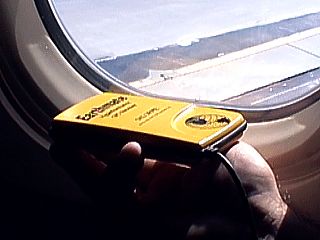Jet Streak!
Good day everyone,
Wonderful subject ... As I used my trusty GPS hooked up to my lap top en route to the Denver Convention amd sure enough, caught the effects of the relentless headwinds while being bumped around by all the CAT (not the animal, but Clear Air Turbulence)...
Here is the GPS unit, held to the window, to receive the satellites. It must be held / placed at the window ... The aluminum fusalage of the airplane is an effective "faraday cage" and blocks much reception inside.
Now for the good stuff... This is an annotated picture showing GPS measurements of ground-speed when crossing a region of strong winds aloft associated with the core of a jet stream.
In this diagram, the first measurement was taken over central Lousiana west of New Orleans, in an MD-80 at about 37,000 feet with a ground speed of about 417 MPH. With an airspeed of 575 MPH (this airspeed was constant in all three measurements, with a heading to the WNW), the jet stream component is about 158 MPH.
The next left inset, measured over far west Lousiana, shows a ground speed of 389 MPH, giving a jet component of 186 MPH. Finally, after crossing into far E Texas airspace, ground speed rather suddenly dropped to only 372 MPH (most likely as the "core" of the jet stream, or jet "streak" was crossed), yielding a jet-stream "core" component of 203 MPH.
A turn to the WSW, heading more into the strong WSW winds aloft, yielded a lowest ground speed of 349 MPH (not shown), suggesting a jet streak of 226 MPH. Speaking about being "late", imagine flying the other way?
Here is a picture above, but from a different flight, from California to Texas just eas tof the front range over SE Colorado at about 31,000 feet ... Kewl lenticular clouds! Jet stream helped here, got in 30 minutes early!



